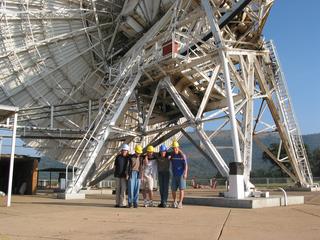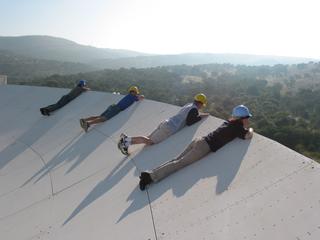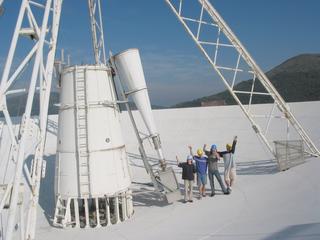
Left click on image for large version

HartRAO Home > news > RAU students' Radio Astronomy Practical 2004/04/24
The practical started by using a satellite dish to measure the brightness temperature of the Sun, and then to deducing its physical temperature at the satellite dish working frequency of 12 GHz.
Extending this concept, the students then did numerical predictions as to whether the planets in the solar system would produce radio emission and whether this would be detectable with the 26-m radio telescope. Observations to test the predictions followed.
Sunday morning dawned bright and clear and it was time for the students to climb the telescope and get a close-up look at the microwave receivers. This is pictured below. Parallel processing then allowed the data from the planets to be reduced before the students departed on Sunday afternoon.
The second weekend began within an introduction to radio-frequency spectroscopy. The telescope was used to observe radio continuum and recombination line emission from the well-known Orion nebula, enabling its temperature to be measured.
On Saturday evening, optical telescopes let the students get a look at the objects they had been studying - the Orion nebula and Venus, Mars, Jupiter and Saturn.
This was followed by an investigation into the radio emission from pulsars. Pulsar timing not only gives us information about the interior of neutron stars but also allows us to find out more about the interstellar medium between us and the pulsar. The students derived the dispersion measure towards a pulsar by finding the differential delay in the pulse arrival times at different frequencies. In addition, a long set of data from a pulsar were used to measure its spin-down rate, and thus infer its characteristic age.

Preparing for the ascent...

Inside the monster. The students on the hour angle skid, where motors drive the telescope east - west through a large gear wheel.

Its a great view over the edge of the dish.

The feed system for the 18cm wavelength receiver dwarfs the students.